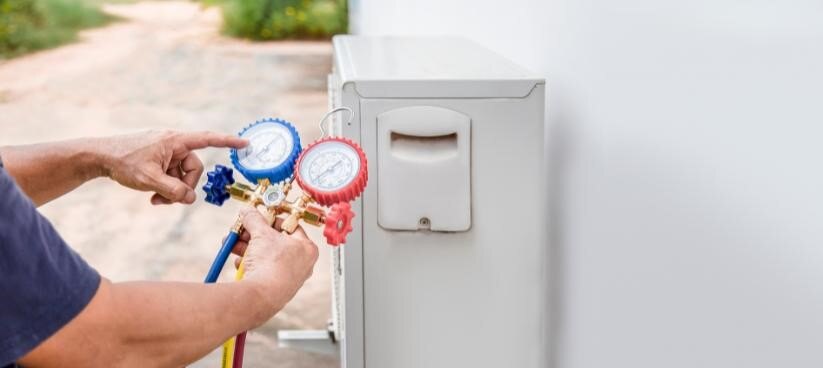When selecting a refrigerant for HVAC systems, it's essential to consider various factors including environmental impact, efficiency, and compatibility with existing systems. Four commonly discussed refrigerants are R22, R410A, R32, and R454. Let's dive into the pros and cons of each and how they affect home comfort and HVAC systems.
What is Refrigerant?
Refrigerant is a substance used in HVAC (Heating, Ventilation, and Air Conditioning) systems to absorb heat from the environment and release it elsewhere, thus enabling cooling and heating. Refrigerants cycle through the system, changing from a gas to a liquid and back, in a process that extracts heat from inside a building and expels it outside. The efficiency and environmental impact of an HVAC system greatly depend on the type of refrigerant used.

A Brief History of R410A, R32, and R454 Refrigerants
R22 history
-
Introduction: R22, also known as chlorodifluoromethane, is a hydrochlorofluorocarbon (HCFC) that was widely used from the mid-20th century.
-
Development: Became popular for residential and commercial air conditioning and refrigeration systems due to its efficiency and safety profile.
-
Phase-out: The production and import of R22 were phased out in many countries starting in 2010, with a complete ban in effect since 2020 in the United States due to its ozone-depleting potential.
R410A history
-
Introduction: R410A, a hydrofluorocarbon (HFC) blend of difluoromethane (R32) and pentafluoroethane (R125), was introduced in the early 1990s.
-
Adoption: It became widely adopted in the mid-1990s as a replacement for R22 (chlorodifluoromethane), which was being phased out due to its ozone-depleting potential.
-
Usage: R410A became the standard for residential and commercial air conditioning systems in many parts of the world due to its superior efficiency and safety profile compared to R22.
R32 history
-
Introduction: R32, or difluoromethane, is an HFC refrigerant that has been known since the 1930s.
-
Development: Its use in air conditioning systems became prominent in the early 21st century as the industry searched for alternatives to high-GWP refrigerants like R410A.
-
Adoption: Japan was one of the first countries to adopt R32 widely, with other regions following suit as regulatory pressures to reduce GWP increased.
R454 history
-
Introduction: R454 blends, such as R454B, are relatively new refrigerants developed in response to increasing environmental regulations.
-
Development: These blends were developed in the 2010s as a low-GWP alternative to R410A and other high-GWP refrigerants.
-
Adoption: Adoption has been growing globally, particularly in Europe and North America, as industries and regulators push for more environmentally friendly HVAC solutions.
R22 Refrigerant Pros and Cons
Pros
-
Efficiency: Historically known for good efficiency in cooling and heating.
-
Stability: Non-flammable and relatively safe to handle.
-
Compatibility: Widely used in many existing older HVAC systems.
Cons
-
Environmental impact: High Ozone Depletion Potential (ODP) and significant GWP.
-
Phase-out: Production and imports are banned in many countries, making it increasingly expensive and hard to find.
-
Maintenance: Existing R22 systems require more frequent maintenance due to the age of these systems.
R410A Refrigerant Pros and Cons
Pros
- Efficiency: R410A offers high energy efficiency, contributing to lower electricity bills and effective cooling and heating.
- Stability: This refrigerant is chemically stable, non-flammable, and non-toxic, making it safe for residential use.
- Availability: R410A is widely available and has been the standard for residential HVAC systems for years.
Cons
- Environmental impact: R410A has a high Global Warming Potential (GWP) of 2088, significantly contributing to climate change.
- Phase-out: Due to its environmental impact, R410A is being phased out in many regions in favor of more eco-friendly alternatives.
- Operating pressure: It operates at higher pressures than some other refrigerants, which can lead to increased wear and tear on HVAC components and shorter lifespan.
- Dehumidification: R410A has been known to provide less effective dehumidification thereby reducing home comfort levels.
R32 Refrigerant Pros and Cons
Pros
- Efficiency: R32 is highly efficient, often more so than R410A, leading to better performance and energy savings.
- Environmental impact: With a GWP of 675, R32 has a significantly lower impact on global warming compared to R410A.
- Cooling capacity: It has superior thermodynamic properties, which can improve the cooling capacity of HVAC systems.
Cons
- Flammability: R32 is mildly flammable (classified as A2L), which requires careful handling and specific safety measures during installation and maintenance.
- Retrofit complexity: Switching from R410A to R32 in existing systems can be complex and may require significant modifications.
R454 Refrigerant Pros and Cons
Pros
- Environmental impact: R454 blends, such as R454B, have a low GWP (around 466), making them a more environmentally friendly option.
- Efficiency: These blends maintain good energy efficiency, similar to or better than R410A, providing effective cooling and heating.
- Retrofit potential: R454 blends can be a suitable replacement for R410A with minimal modifications, making them a convenient option for retrofitting existing systems.
Cons
- Flammability: Similar to R32, R454 blends are also mildly flammable (A2L classification), necessitating careful handling and specific safety protocols.
- Availability and cost: Being relatively new to the market, R454 blends might be less available and more expensive than traditional refrigerants.
Choosing the Right Refrigerant for Your HVAC System
Choosing the right refrigerant depends on balancing environmental concerns, system efficiency, safety, and cost. R410A, while effective and widely used, is being phased out due to its high GWP. R32 offers superior efficiency and a lower environmental impact but comes with flammability concerns. R454 blends provide a promising alternative with low GWP and good performance, though they also require careful handling due to mild flammability.
For homeowners and HVAC professionals, the decision involves considering immediate needs, future regulatory changes, and long-term environmental impact. Retrofitting existing systems might favor R454 blends, while new installations could benefit from the efficiency of R32, provided safety measures are in place. To learn more and see which is right for you, contact us today!
If you live in the Delaware Valley/Greater Philadelphia area and would like to find comfort within your home, visit our website or give us a call at 215 - 245 - 3200 to learn more.




